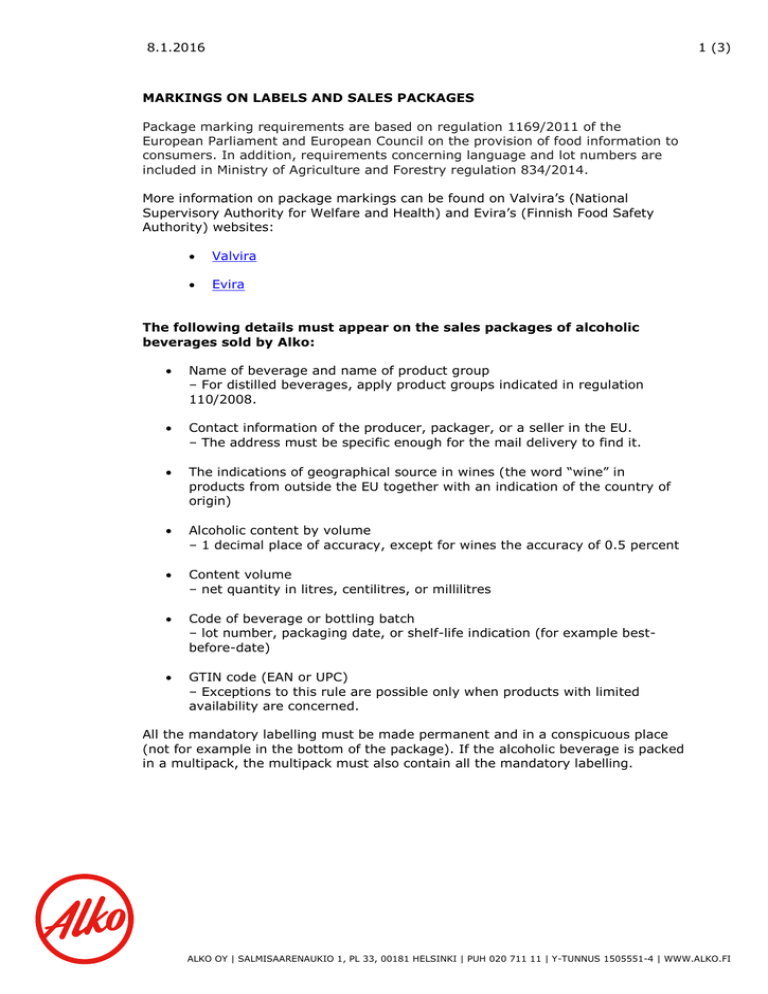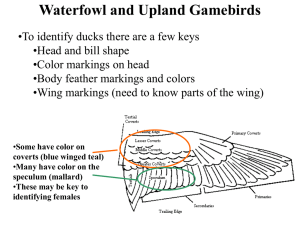8.1.2016 1 (3) MARKINGS ON LABELS AND SALES PACKAGES
advertisement

8.1.2016 1 (3) MARKINGS ON LABELS AND SALES PACKAGES Package marking requirements are based on regulation 1169/2011 of the European Parliament and European Council on the provision of food information to consumers. In addition, requirements concerning language and lot numbers are included in Ministry of Agriculture and Forestry regulation 834/2014. More information on package markings can be found on Valvira’s (National Supervisory Authority for Welfare and Health) and Evira’s (Finnish Food Safety Authority) websites: Valvira Evira The following details must appear on the sales packages of alcoholic beverages sold by Alko: Name of beverage and name of product group – For distilled beverages, apply product groups indicated in regulation 110/2008. Contact information of the producer, packager, or a seller in the EU. – The address must be specific enough for the mail delivery to find it. The indications of geographical source in wines (the word “wine” in products from outside the EU together with an indication of the country of origin) Alcoholic content by volume – 1 decimal place of accuracy, except for wines the accuracy of 0.5 percent Content volume – net quantity in litres, centilitres, or millilitres Code of beverage or bottling batch – lot number, packaging date, or shelf-life indication (for example bestbefore-date) GTIN code (EAN or UPC) – Exceptions to this rule are possible only when products with limited availability are concerned. All the mandatory labelling must be made permanent and in a conspicuous place (not for example in the bottom of the package). If the alcoholic beverage is packed in a multipack, the multipack must also contain all the mandatory labelling. ALKO OY | SALMISAARENAUKIO 1, PL 33, 00181 HELSINKI | PUH 020 711 11 | Y-TUNNUS 1505551-4 | WWW.ALKO.FI 2 (3) Further markings which are required in certain cases Best-before-date (beverages with an alcoholic strength by volume maximum 10 %) – not required for wines nor similar products made of fruit (for example ciders) Country or place of origin (must be marked, in case there is a possibility of its absence misleading the consumer in regard to the origin of the product) Identification of genetic modification of ingredients – Markings must conform to Regulation 1829/2003. Allergy causing ingredients must be marked both in Finnish and Swedish either by highlighting them in the list of ingredients or by denoting with the words “Sisältää...” and “Innehåller...”. For example, the following ingredients cause allergic reactions: o sulphites and sulphur dioxide o cereal containing gluten o nuts and almond o milk and dairy products o fish products o eggs and egg products Production of wine sometimes uses albumen and lysozyme which originate from eggs, or alternatively caseine which is a dairy product. Use of these compounds must be indicated on products labelled after 30 June 2012. Such indication is not required, if albumen, lysozyme or caseine cannot be detected in the end product by analytical methods. In addition to allergen markings in Finnish and Swedish, pictograms presented in regulation 579/2012 can be used, but they do not replace verbal allergen markings. Warning statements related to ingredients: The following ingredients must be stated: o artificial sweeteners (EU 1169/2011) o caffeine and quinine (EU1169/2011) o liquorice and glycyrrhizinic acid (EU 1169/2011) o Bottler (for sparkling wines: producer or seller) For products from third countries: importer into the European Union (name and address) For sparkling wines: sweetness indication The name (designation) of the wine, its content volume and alcohol content must be in a single visual field (on the label). Alcohol content must be indicated in characters and numbers at least 3 mm high, with accuracy of 0.5 percentage unit, with the exception of Australian and Swiss wines, where the content can be indicated with accuracy of 0.1 percentage unit. 3 (3) If carbon dioxide has been added to a sparkling wine, this must appear from the label. For vintage wines at least 85 % of the grapes must be harvested in the indicated crop year. If several grape varieties are stated, they must be in the order of magnitude. Additional information on wine package markings Wine package markings must be made in one or more of the EU official languages in a way that it is easy for the final consumer to understand all the markings. Allergen markings must be in Finnish and Swedish. The wine package markings are regulated by the following regulations and their amendments: Regulation 1169/2011 of the European Parliament and the Council on the provision of food information to consumers Regulation 753/2002 of the European Commission on indicating the actual alcoholic strength by volume on labels Regulation 1308/2013 of the European Parliament and the Council on establishing a common organisation of the markets in agricultural products Commission implementing regulation 579/2012 regarding the indication of allergens The Council regulation 479/2008 Commission Regulation 607/2009 of 14 July 2009 laying down certain detailed rules for the implementation of Council Regulation (EC) No. 479/2008 as regards protected designations of origin and geographical indications, traditional terms, labelling and presentation of certain wine sector products Directive 2007/45 of the European Parliament and the Council on laying down rulse on nominal quantities for prepacked products
